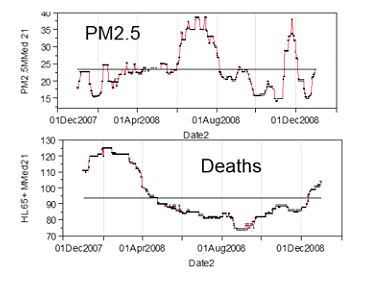Sounds awful for city dwellers, right? Breathe easy, the pollutant they measured has yet to be linked to any harm, and no acute deaths, outside government claims when they want to restrict businesses.
The team evaluated air quality using a metric called PM2.5, which measures the mass of particulate matter, airborne particles smaller than 2.5 micrometers per cubic meter of air. The belief is that larger particles get caught in your nose or throat - a typical human hair is 50 to 100 micrometers wide - but smaller ones do not. Why is that a worry? Toxicologists know that lots and lots of small particles make it into lungs every day. Unless it's mustard gas, that does not make it harmful. However, to some, the presence of any pathogen equates to pathology, ignoring that the dose makes the poison.
To make their case that Canadian subway residents are at risk of getting cancer, scholared collected data on TTC platforms and in trains over three weeks in the summer of 2010 and the winter of 2011. They used portable detectors for particulate matter and found them to be much higher than in the ambient air outside. A typical outdoor PM2.5 value for Toronto would be on the order of 10 micrograms of particles per cubic meter of air, they say, while on a poor air quality day in Toronto, that value might rise as high as 30 micrograms per cubic meter, and they assert the particles would be visible in the air as haze.
On Toronto subway platforms and trains, the team measured an average value of 100 micrograms per cubic meter, comparable to very polluted Beijing.
While true, it is a strawman. It is not PM 2.5 that harms people in Beijing, it is PM 10. North America has some of the cleanest air in the world, the EPA decision to limit PM 2.5 in its latest round of regulations was not based on evidence, there was none. An analysis of the largest set of deaths in California, which leads the US in air regulations, by the consumer advocacy group American Council on Science and Health, found zero deaths due to PM 2.5, whereas PM 10 has been long established.

Another confounder in the study: Toronto subway trains are electric, so measurements may not be accurate. Instead, the authors violate Occam's razor and speculate that abrasion between the wheels and track of the train is grinding off tiny steel particles. As each train comes into the station, it pushes a column of air in front of it, which stirs up these particles along with any other dust settled at track level. To affirm that, they note in aboveground stations, such as Rosedale and Davisville, the team found that PM2.5 measurements were about half what they were underground. Vancouver's Skytrain system, which is primarily aboveground, also had much lower average PM2.5 values at, 17 micrograms per cubic meter. Montreal's system, while entirely below ground, averaged 36 micrograms per cubic meter, which they believe may be because its rubber wheels, concrete rails, and wood-based braking system leads to less abrasion than steel-on-steel.
In Canada, PM 2.5 has not been linked to any harm, so current Health Canada guidelines simply recommend that indoor PM2.5 levels be kept "as low as possible."






Comments